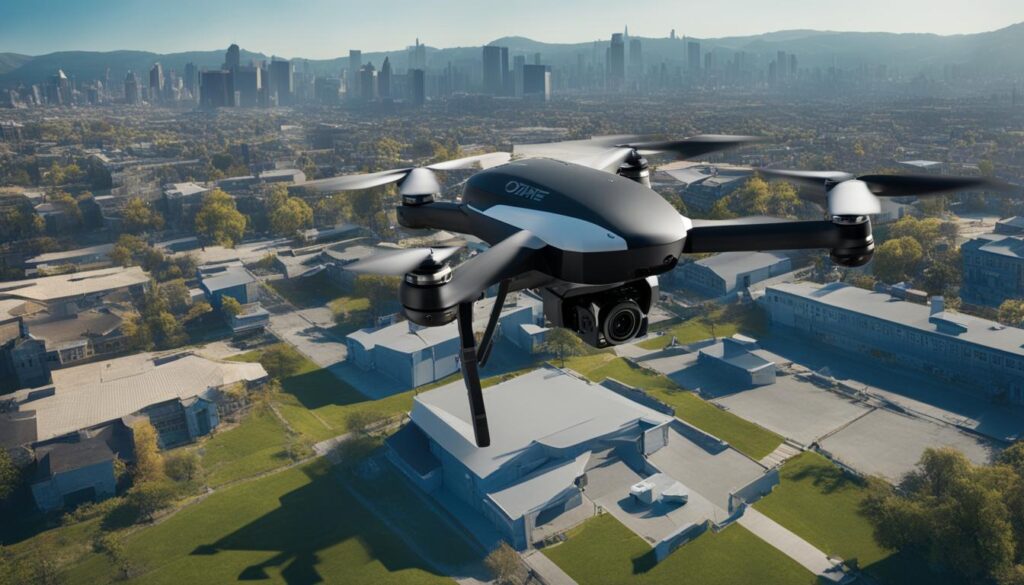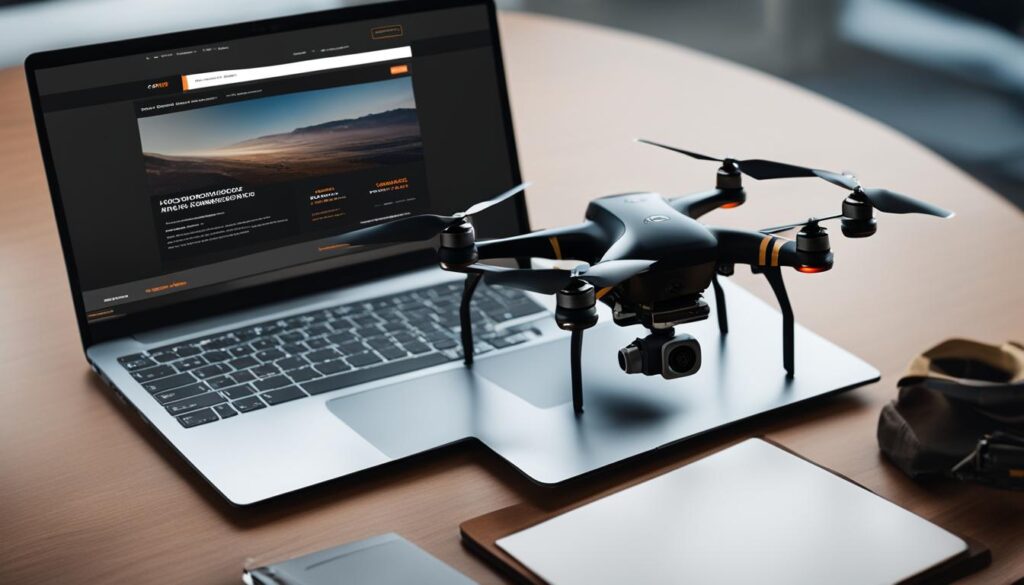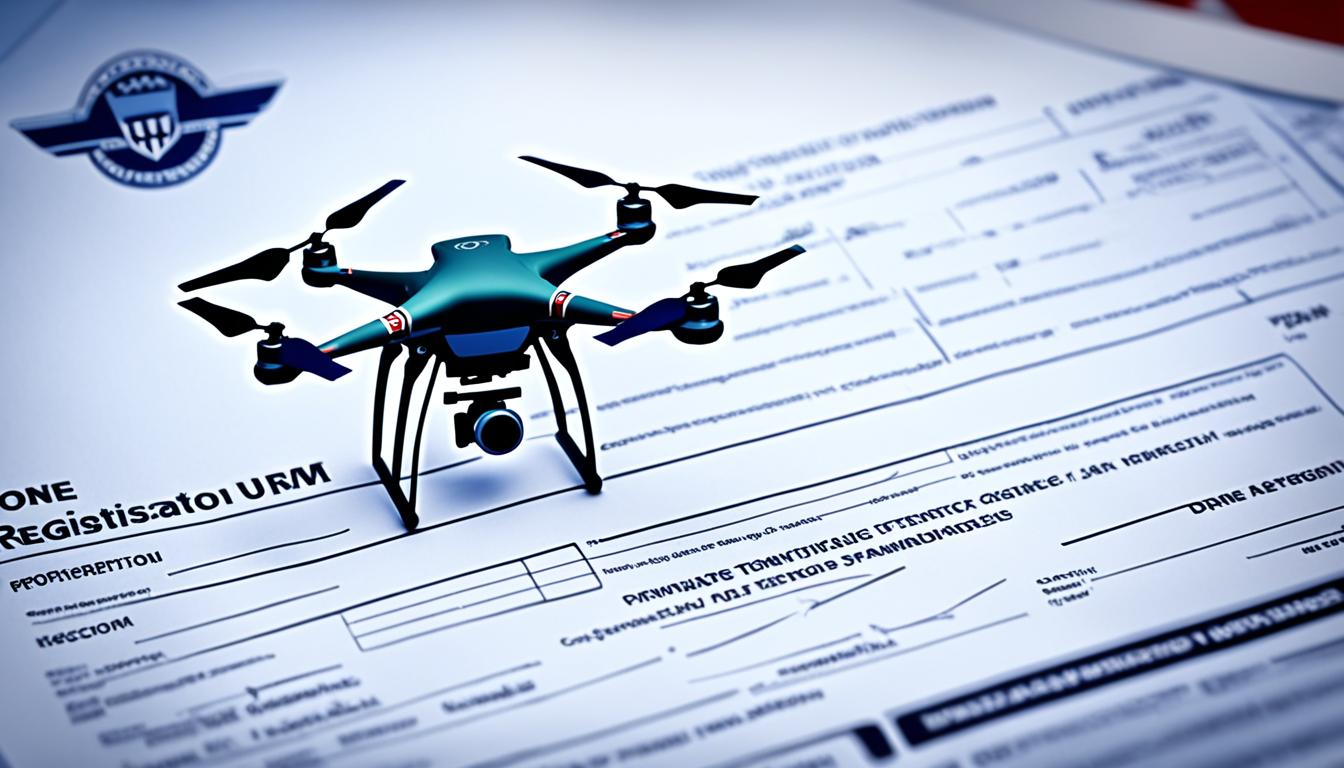Navigating the skies with your drone involves more than just skillful maneuvering; it mandates a thorough understanding of the FAA drone registration regulations. Whether you are a hobbyist or a commercial pilot, registering a drone with the government is a key step to ensuring legal and safe flight operations.
The drone registration process provides an avenue for accountability and helps in maintaining a safe environment for all users of the National Airspace System (NAS). For those new to drone operations, we’ve compiled a step-by-step drone registration guide to help simplify the complexities of adhering to the Federal Aviation Administration’s requirements.
Join us as we delve into the specifics of the registration process, including important safety tips, airspace restrictions, and additional considerations for drones exceeding 55 pounds or operated by international pilots. Keep flying high and legally with our expert guidance!
What is FAA Drone Registration?
The concept of drone ownership is incomplete without understanding the FAA’s integral role in the safe operation of these devices. For anyone pondering how to register a drone, it’s essential to comprehend that registration serves as a cornerstone of responsible drone flight and management in the United States. As we zoom in on the FAA drone registration requirements, it becomes evident that this process is more than a formality—it’s a critical step towards ensuring the accountability and safety of drone pilots and the wider public.
Definition and Purpose
Registering a drone, particularly one that weighs from 0.55 lbs to up to 55 lbs, is more than just getting a number to slap on your aircraft. It is a procedure designed for transparency and tracking, necessitating the provision of vital data to the FAA. The mandatory submission of such information underlines the significance of the drone registration deadline and its role in fostering a culture of informed flight practices. This registration mechanism is instrumental in instigating constructive habits among UAS operators, thereby cultivating an environment where the skies are navigated with knowledge and respect for shared space.
The Role of the FAA in Drone Regulation
The FAA’s arm of regulation extends beyond the mere collection of applications; it is involved in the meticulous crafting and enforcement of policies. When you embark on the drone registration application process, you are actively engaging with a body that positions itself at the helm of aerial innovation and responsible flight operability. The FAA dilutes the abstract concept of aerial freedom with the tangibility of rules and guidelines, ensuring that the act of flying these sophisticated machines is aligned with overarching safety protocols and ethical standards.
Determining the Need for Registration
Before registering a drone with the government, operators must identify whether their drone meets the drone registration requirements outlined by the FAA. Factors such as the purpose of operation and the weight of the drone play a critical role in this determination. Below, we explore the nuances involved in these criteria, helping you navigate the complexities of registration.
By Drone Type: Recreational, Commercial, and More
Recreational drone users enjoy a simplified registration process, with a single ID number covering all their drones. In contrast, commercial drone operators must tackle the registration of each UAS, reflecting the higher stakes involved in their activities. This distinction is also observed in operations conducted by public entities and educational institutions, each governed by specific regulations.

By Drone Weight: Understanding the Threshold
The threshold of 0.55 lbs is the determining factor for drone registration. Drones below this weight are generally exempt from the process unless utilized for non-recreational purposes. It’s the owner’s responsibility to be aware of their drone’s weight and understand that breaching this threshold obligates them to comply with the FAA’s legal requirements.
Use Cases: When Does Your Drone Require Registration?
Diverse use cases necessitate a thorough examination of your operation’s nature. Whether it’s for commercial photography, educational purposes, or public service missions, understanding the specific scenario can clarify your obligations. Registering a drone with the government is compulsory for drones over 0.55 lbs, and any commercial endeavor, regardless of weight, demands strict adherence to FAA guidelines.
Preparing for the Drone Registration Process
Before commencing the drone registration application, it’s essential for both individuals and organizations to gather the right documents and understand the steps on how to register a drone. The ability to navigate through this process efficiently requires an awareness of the information and resources necessary for successful registration.
Registration for Individuals and Businesses
Whether you’re a hobbyist or a commercial operator, the FAA mandates that your drone be registered accordingly. This section will guide you through the preparatory steps for both individuals and businesses, outlining what to expect during the registration application and how to ensure you comply with all FAA requirements.
Documents and Information You Will Need
To smooth out the registration process, make sure you have all the required personal and drone-specific details ready. Are you set with everything listed?
| Personal Requirements | Drone Requirements | Payment Information |
|---|---|---|
|
|
|
Have these facts at your fingertips to eliminate any hold-ups when filling out your drone registration application, and to ease the overall process of complying with FAA regulations.

The Step-by-Step Drone Registration Guide
Embarking on the journey of drone operation begins with a vital step: registering your drone. This essential measure, enforced by the Federal Aviation Administration (FAA), ensures you comply with the legal requirements necessary to maintain airspace safety and personal accountability. Let’s navigate the step-by-step drone registration guide and detail how to register your drone posthaste.

To commence, the FAA DroneZone portal serves as your starting point. This online platform is meticulously designed to assist both hobbyists and commercial drone operators in the registration process. Here’s a concise outline to guide you through:
- Visit the FAA DroneZone website to ascertain your required registration category based on your operational intention—either as a hobbyist or for commercial purposes.
- Account creation is next. If you’re a new user, establish your profile by signing up; if you’re a returning user, simply log into your existing account.
- Fill out the registration form with diligence and precision, inputting all necessary personal and unmanned aerial system (UAS) details.
- Proceed to the payment stage, where you’ll settle the requisite registration fee via a secure transaction.
Upon successful fee remittance, the FAA will bequeath you with an official registration number alongside a conclusive Certificate of Aircraft Registration, which will be forwarded to you electronically.
The registration number bestowed by the FAA is not merely a formality; it serves as an identifier as unique to your drone as a fingerprint is to an individual.
It’s paramount that you affix the registration number visibly on your drone, ensuring it’s legible on an external surface. Moreover, during any operational flight activity, you’re mandated to possess your registration certificate—another cornerstone in safeguarding responsible and lawful drone utilization.
| Registration Phase | Action Items | Notes |
|---|---|---|
| FAA DroneZone Navigation | Identify as a hobbyist or commercial operator | Choose the category that aligns with your drone use |
| Account Management | Create or log into your FAA account | Required for initiating the registration process |
| Information Submission | Complete the UAS registration form with personal and drone details | Accuracy is critical for legitimate registration |
| Fee Payment | Use a credit or debit card to pay the fee | Secure online transaction ensures your registration is processed |
| Labeling & Certificate Carriage | Label drone with registration number; carry certificate during flights | Compliance with these steps is legally required |
Adhering to this step-by-step drone registration guide will confer peace of mind, knowing you’re flying within the bounds of federal regulation. More importantly, it endorses safety for both the skies and the public at large.
Navigating the FAA DroneZone: A User’s Manual
For drone enthusiasts and professionals alike, understanding how to navigate the FAA DroneZone is crucial for meeting the FAA drone registration and oversight requirements. This centralized system not only facilitates the drone registration application but also serves as a comprehensive platform for managing your entire drone portfolio and compliance documents.

Creating an Account
To get started in the FAA DroneZone, stakeholders need to create an account that will act as the hub for their drone management activities. Account creation is straightforward and begins with providing basic information such as your name, email address, and a secure password. It’s important to designate a responsible individual who will handle the account administration and ensure all drone operations are compliant with current regulations.
Adding Drones to Your Inventory
Once your account is set up, the process continues by adding your drones to the inventory. Each drone requires specific details, including the make and model, as well as a unique identifier that will be associated with it post-registration. This step is critical in building a structured overview of all drones under your operation, whether for hobbyist or commercial purposes.
Role Designation for Team Members
In the case of businesses or organizations with multiple drone operators, the FAA DroneZone allows for role designation amongst team members. Each member can be assigned tailored permissions, enabling clear delineation of duties. Roles such as “Part 107 Administrator” or “Inventory Manager” ensure proper management of the UAS fleet and facilitate a collaborative environment within the regulatory framework.
Streamlining the process of FAA drone registration and fleet management is a cornerstone of the Part 107 dashboard within the FAA DroneZone. By meticulously following these steps, you ensure that your drone operations are not only compliant with the relevant laws but also organized efficiently for future scalability and accountability.
Drone Registration Fees and Renewal Schedules
Understanding the costs associated with drone registration is crucial for pilots. The FAA has set drone registration fees to be affordable and accessible, thereby encouraging compliance. Yet, it’s important for drone owners to note the differences in costs between hobbyist and commercial operator registrations, as well as the schedule for renewing these registrations.
Cost Structure for Hobbyists vs. Commercial Operators
The FAA mandates that drone registration fees are paid to maintain an organized and accountable system of air traffic. A nominal fee of $5 is required for hobbyist drone pilots, which allows them to register multiple drones under a single number. In contrast, commercial operators must invest the same amount for each drone they wish to operate. This fee system underscores the FAA’s effort to streamline FAA drone registration while also distinguishing between different types of drone usage.
| Drone Operator Type | Registration Fee | Coverage |
|---|---|---|
| Hobbyists | $5 | All drones owned by a single individual |
| Commercial Operators | $5 per drone | Each drone registered individually |
Renewal Process: Keeping Your Registration Current
To ensure legality and remain compliant, drone owners must keep their FAA drone registration current by renewing it every three years. The renewal fee remains at $5, the same as the initial registration cost. Pilots can follow a step-by-step drone registration guide available online to complete this process through the FAA DroneZone. Timely renewal is of the essence. Delaying or failing to renew may interrupt your ability to operate your drones legally.
After Registration: Compliance and Flight Guidelines
Following the successful completion of your FAA drone registration, it is imperative to embrace the subsequent steps to guarantee compliance with federal regulations and to ensure you’re adhering to proper flight practices. Familiarity with drone registration requirements remains a cornerstone for responsible operation in the skies. Below, we detail essential guidelines and obligations that should be a part of every drone pilot’s post-registration checklist.
Understanding airspace rules specific to your planned area of operation is vital for all drone pilots. It is your responsibility to stay well within the visual line-of-sight of your drone, ensuring it is always observable without the assistance of any devices. Altitude is another critical factor; pilots are obligated to operate their drones at or beneath the 400-foot ceiling. Familiarization with any distinct airspace constraints, which can vary based on location, is non-negotiable for safe flight operations.
Carrying documentation during each flight is another aspect of the post-registration protocol. This includes a copy of the drone’s registration certificate and any pertinent waivers or authorizations. To avoid infringements and to be prepared for any potential audits by authorities, this practice should be habitual.
| Requirement | Details |
|---|---|
| Visual Line-of-Sight | Must keep the drone within visual range unaided by any devices other than corrective lenses. |
| Maximum Operating Altitude | Do not fly above 400 feet in controlled airspace without proper authorization. |
| Registration Documentation | Carry a physical copy or digital version of the FAA registration certificate during flight. |
| Waivers and Authorizations | Keep readily available any waivers required for specific operations, such as night flying. |
| Recurrent Training (for commercial pilots) | Complete required trainings every 24 months to maintain the currency of the Remote Pilot Certificate. |
Commercial drone pilots have additional responsibilities; it is imperative to maintain a current Remote Pilot Certificate, which necessitates recurrent training every two years. By staying up to date with these training requirements, commercial pilots ensure they are knowledgeable about the latest regulations and safety procedures critical to professional drone operations.
To conclude, regulatory compliance and strict adherence to flight guidelines post-FAA drone registration are not merely regulatory formalities; they form the overarching framework for safe and responsible drone piloting. As a drone operator, respect for these critical parameters is foundational to maintaining the integrity of our shared airspace and the safety of all who rely on it.
International Pilots: Registering a Foreign Drone
As the skies become increasingly globalized, International UAS Operators in the United States face distinctive challenges and responsibilities. Recognizing the importance of adhering to FAA drone registration rules, foreign drone operators must take additional steps to ensure full compliance within U.S. airspace. Before we delve into the specifics, it’s essential to understand these foundational requirements.
Special Considerations for Non-U.S. Operators
When it comes to foreign drone registration, the FAA mandates specific conditions tailored for non-U.S. operators. These rules are in place to protect the integrity of U.S. airspace while allowing international pilots to integrate drones into their operations. Key considerations include verifying the weight and purpose of the drone, understanding temporary flight authorizations, and ensuring that operators are up to date with changing regulations.
Among the nuances, foreign operators must navigate, registering a drone in the USA stands out for its unique process and set of rules, compared to those for domestic pilots. Let’s take a closer look at the resources these pilots have at their disposal.
Resources Available for International Pilots
The FAA provides valuable resources designed to assist international pilots in navigating the complexities of drone registration. These tools are crafted to clarify the steps needed to legally operate drones within the United States. Here is a breakdown of resources that foreign drone pilots can find particularly beneficial:
- FAA’s Page for International UAS Operators: A comprehensive guide highlighting the procedures and requirements for foreign-operated drones.
- Guidance on Drone Weight: Detailed information regarding the rules for drones that exceed 55 pounds and instructions for registration.
- Temporary Flight Operations: Regulations and authorizations for short-term operations within U.S. airspace.
It’s paramount for international operators to consult these aids to ensure a smooth experience when applying for registration and to prevent potential disruptions in their drone operation plans.
Conclusion
The importance of the Drone Registration Process Explained cannot be overstated for those aspiring to pilot drones in U.S. skies. Whether for recreation, commercial ventures, or educational purposes, following the FAA’s guidelines is not merely a formality; it is a critical step toward ensuring the safety and accountability of our shared airspace.
Bearing in mind the drone registration deadline and the associated drone registration fees, compliance not only fortifies the integrity of aviation but also serves as a badge of professionalism and responsibility for pilots. The streamlined procedures set forth by the FAA are designed to make this process as user-friendly as possible, promoting a culture of compliance and safety.
In conclusion, it is incumbent upon both domestic and international drone operators to abide by these regulations. As drone technology advances and utilization soars, adherence to the established registration process will facilitate legal, enjoyable, and above all, safe flight experiences for all participants in the ever-evolving landscape of aerial innovation.
FAQ
What is FAA Drone Registration?
FAA drone registration is a system that requires drone owners to provide the Federal Aviation Administration with important information about their drones and themselves. The registration helps ensure safer skies by linking drones to their operators and educating owners about flight rules.
What is the role of the FAA in Drone Regulation?
The Federal Aviation Administration (FAA) regulates the use of drones within the National Airspace System (NAS) to maintain safety and enforce accountability. It establishes rules for drone pilots, sets conditions for registration, and manages the FAA DroneZone for the application process.
How do I determine the need for drone registration?
The need for registration is based on your drone’s operations such as recreational, commercial, or educational use, and the drone’s weight. Drones between 0.55 lbs and 55 lbs used for recreational purposes must be registered, and each drone used for commercial purposes must be individually registered.
What documents and information are required for drone registration?
You will need personal details such as name, address, email, and phone number along with drone specifics like make, model, and serial number. A form of payment is also required for the registration fee. Individuals must be at least 13 years old and a U.S. citizen or legal permanent resident to register.
Can you provide a step-by-step guide to registering a drone?
Sure! Start by visiting the FAA DroneZone website, select the type of operation (recreational or commercial), create an account or log in, fill out the form with personal and drone details, pay the registration fee, and upon completion, label your drone with the registration number.
How do I navigate the FAA DroneZone to register my drone?
Begin by creating an account to set up your profile. Once done, you can add drones to your inventory, designate roles for team members, and manage certifications from the Part 107 dashboard within your account.
What are the registration fees and renewal schedules for drones?
Hobbyist drone pilots pay a fee of which covers all drones owned under a single number. Commercial pilots pay per drone. Registration is valid for three years and must be renewed before expiration. Renewal follows a similar process as the initial registration through the FAA DroneZone.
What are my responsibilities after registering my drone?
Post-registration, you must follow compliance requirements and flight guidelines, including staying within visual line-of-sight, flying below 400 feet, and being mindful of airspace restrictions. Commercial pilots must also maintain a current Remote Pilot Certificate.
What special considerations are there for international pilots registering a drone in the U.S.?
Non-U.S. operators must comply with additional requirements detailed on the FAA’s International UAS Operators page. This includes information on operating drones over 55 pounds and regulations for temporary flights in U.S. airspace.
Where can international pilots find resources about FAA drone registration?
International UAS Operators can find valuable resources and guidance on the FAA website, which includes information on regulatory compliance for operating drones within the U.S. as foreign operators.

Leave a Reply